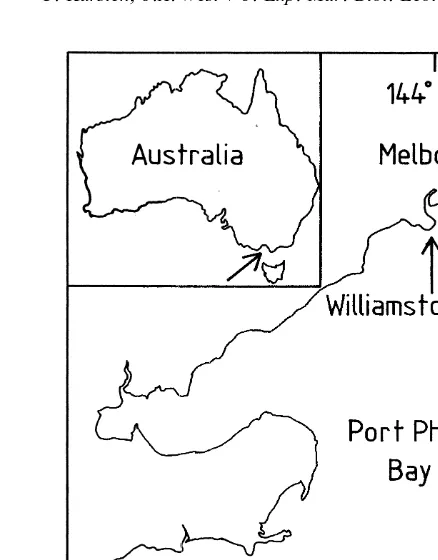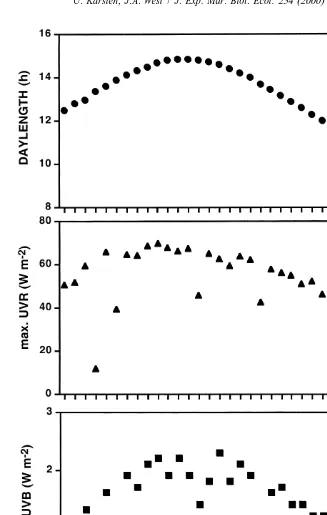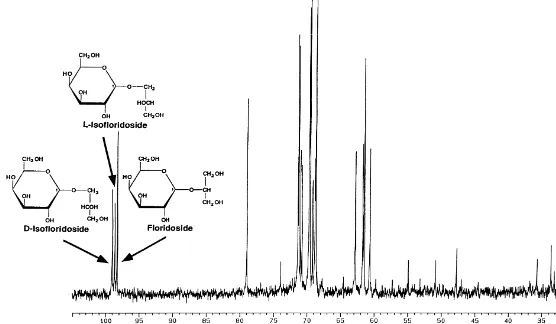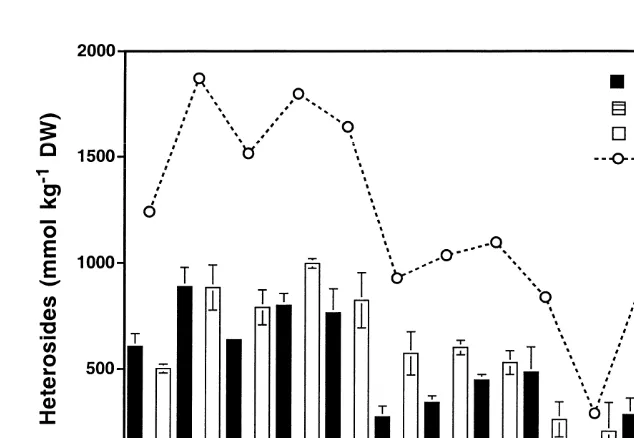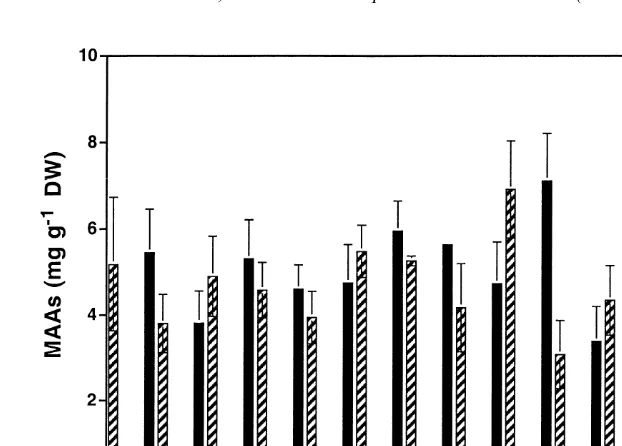254 (2000) 221–234
www.elsevier.nl / locate / jembe
Living in the intertidal zone — seasonal effects on
heterosides and sun-screen compounds in the red alga
Bangia atropurpurea (Bangiales)
a ,* b
U. Karsten , J.A. West
a
Alfred-Wegener-Institute for Polar and Marine Research, Am Handelshafen 12, D-27570 Bremerhaven, Germany
b
School of Botany, University of Melbourne, Parkville VIC 3052, Australia
Received 20 April 2000; received in revised form 23 June 2000; accepted 11 August 2000
Abstract
The seasonal patterns of daylength and ultraviolet radiation (UVB and UVA) at Williamstown, Victoria, Australia were measured (October 1995–May 1996) and are considered in relation to levels of heterosides (soluble sugar compounds:D-isofloridoside, floridoside andL-isofloridoside) and sun-screen compounds (mycosporine-like amino acids: MAAs) in the intertidal red alga
22
Bangia atropurpurea. UVB peaked in December–January at 2.2–2.4 W m and UVA also
22
peaked at 70 W m in the same period. Total heteroside concentrations were highest (1230–1900
21
mmol kg dry weight) during November–December with floridoside andD-isofloridoside being 90% of the total. In late February through mid-April total heteroside contents were lower
21
(315–905 mmol kg dry weight) withL-floridoside being as much as 34% of the total indicating
21 21
a seasonal effect. Total MAAs varied from 3.4 to 7.1 mg g dry weight (mean 4.9 mg g dry weight) with both highest and lowest levels occurring in February. Porphyra-334 constituted 83 to 97% of this total with asterina-330, palythine and palythinol being 3–17%. Although maximum MAA concentrations did not show any significant parallel with the peak UV values, the quantitative data point to Bangia cells over the course of the seasons always loaded up with these photoprotective compounds. 2000 Elsevier Science B.V. All rights reserved.
Keywords: Heterosides; Floridoside;D-isofloridoside;L-isofloridoside; Mycosporine-like amino acids; MAAs; UV radiation
*Corresponding author. Tel.: 149-471-4831-1522; fax: 149-471-4831-1425. E-mail address: [email protected] (U. Karsten).
222 U. Karsten, J.A. West / J. Exp. Mar. Biol. Ecol. 254 (2000) 221 –234
1. Introduction
The red algal genus Bangia is a cosmopolitan taxon typically growing in the upper ¨ litoral zone on marine rocky shores from polar to warm-temperate waters (Luning, 1990), as well in freshwater habitats just above the waterline (Sheath, 1984). Members of this group are ecologically characterized as opportunistic due to rapid growth and high reproductive output allowing the quick colonization of naturally disturbed areas
¨
such as grazed rocks (Muller et al., 1998). In the upper intertidal zone Bangia exists in almost ‘‘terrestrial’’ conditions where it experiences wide fluctuations in the external salinity due to ebb and flow, sometimes associated with long periods of desiccation, as well as long exposure to high light of the visible and ultraviolet range.
The physiological function of the heterosides floridoside (a-D
-galactopyranosyl-(1-2)-glycerol), D-isofloridoside (a-D-galactopyranosyl-(1-1)-D-glycerol) and L-isofloridoside
(a-D-galactopyranosyl-(1-1)-L-glycerol) as organic osmolytes compensating
hyperos-motic conditions has been studied in various Bangiales (Reed et al., 1980; Wiencke and ¨
Lauchli, 1981; Reed, 1985; Karsten et al., 1993). Under hypersaline stress, Porphyra purpurea (Roth) C. Agardh and Bangia atropurpurea (Roth) C. Agardh from Great Britain showed a strong increase in the floridoside concentration only, whereas the content of isofloridoside (no differentiation between D and L form) remained almost
unchanged (Reed et al., 1980; Reed, 1985). These authors concluded that, within the Bangiales, floridoside is always metabolically much more active and hence physiologi-cally more important than isofloridoside. Since in many of the earlier investigations neither D- and L-isofloridoside were distinguished, nor was floridoside separated from
both isofloridosides, some of the scientific conclusions on the physiological importance of floridoside relative to both isofloridosides in members of the Bangiales need to be critically re-evaluated.
13
Using highly accurate C-nuclear magnetic resonance (NMR) techniques, Karsten et al. (1993) demonstrated for B. atropurpurea the quantitative dominance of D
-iso-floridoside over -iso-floridoside and / orL-isofloridoside towards the end of the growth season
in Australia. In a comprehensive study on eight different Porphyra species from different biogeographic regions over the course of the respective growth season the heteroside patterns were determined (Karsten, 1999). The composition of the three compounds varied among the species studied, and conspicuous seasonal variations in the concentrations were measured. In Porphyra columbina Montagne from Australia, L
-isofloridoside was always quantitatively dominant, while floridoside was the major component in Porphyra dioica Brodie et Irvine from Helgoland. In most species studied
D-isofloridoside was usually present in small concentrations, except in Porphyra
perforata J. Agardh from the Pacific USA where it occurred in equal concentrations along with floridoside and L-isofloridoside (Karsten, 1999).
include damage to molecular targets such as DNA, RNA and proteins and inhibition of physiological processes such as photosynthesis and growth (Britt, 1995; Buma et al.,
¨
1995; Franklin and Forster, 1997; Hader and Figueroa, 1997; Aguilera et al., 1999). An important protective mechanism that allows macroalgae living in high-light habitats to survive and reproduce involves the biosynthesis and accumulation of UV sunscreens. The most common substances with a potential role as UV-sunscreens in marine organisms are the mycosporine-like amino acids (MAAs), a suite of chemically closely related, water-soluble compounds. MAAs typically absorb between 310 and 360 nm (Karentz et al., 1991), their function as intracellular screening agents has been inferred, for example, from the partial prevention of UV-induced inhibition of photosynthesis (Neale et al., 1998).
Because there is a lack of detailed ecophysiological studies of seasonally changing environmental factors on the quantitative concentrations of heterosides and MAAs in Bangia atropurpurea the present investigation was undertaken. Samples of this species were collected over the course of the growth season from the same population in the field at Williamstown, Melbourne (Australia).
2. Materials and methods
2.1. Plant material
The marine red alga Bangia atropurpurea (Roth) C. Agardh was collected from the upper eulittoral zone of a rock platform at Williamstown (Port Philips Bay, Melbourne, Australia) (Fig. 1). This species was regularly collected over the growth season of the gametophytic-bladed stage between November 1995 and May 1996. Samples were taken at low tide from the intertidal zone at intervals of 2–4 weeks. In the field algal samples were stored on ice, air-dried or oven-dried at 408C overnight in the laboratory, air-mailed to the Alfred-Wegener-Institute and chemically analyzed. This treatment did not affect the heteroside or MAA concentrations, and such samples could be stored for many months without any degradation when kept under dry, cool and dark conditions.
2.2. Environmental data
At all sampling dates salinity was determined using a hand refractometer. Data on air-and surface water temperature air-and rainfall were collected from the bureau of meteorolo-gy, Melbourne. Data on UV radiation (total UV [290–400 nm], UVB [290–315 nm]) were kindly provided by Dr. H.P. Gies (Australian Radiation Laboratory, Melbourne, Australia), and sun rise and sun set times for the calculation of daylengths were received from Melbourne Observatory.
13
2.3. C-NMR measurements
13
224 U. Karsten, J.A. West / J. Exp. Mar. Biol. Ecol. 254 (2000) 221 –234
Fig. 1. Map showing location of Williamstown, Port Phillip Bay, Victoria. Inset with arrow shows location in Australia.
at 708C. After centrifugation at 5000 g, the supernatant was evaporated to dryness under 13 vacuum and redissolved in 0.5 ml of D O (99.98%) for NMR spectroscopy.2 C NMR spectra were recorded on a Bruker AM-500 spectrometer at 125.77 MHz. Typically, a sweep width of 30 000 Hz, 16 000 time domain points and a 608pulse of 3.5 ms were used for acquisition, with composite pulse decoupling. The free induction decay was zero-filled to 32 000 data points and processed with a line broadening of 1.5 Hz. Samples were contained in spinning 5 mm tubes and spectra were run at 278C and referenced from added dioxane (67.4 ppm). Floridoside, D-isofloridoside and L
-iso-floridoside were verified by comparing with standards isolated from red algae (Karsten et al., 1993).
2.4. Heteroside quantification
Floridoside, D-isofloridoside and L-isofloridoside were quantified by GLC. For these
analyses, the algal samples (10–15 mg DW) were extracted in 1 ml of 70% (v / v) ethanol for about 3 h in a waterbath at 708C. These were then centrifuged for 5 min at
21
ml of the sample supernatant, or to a standard of known concentration, and evaporated to dryness under a stream of dry air. The residue was redissolved in 150ml of pyridine and 75ml of acetic anhydride and acetylated by heating for at least 1 h at 708C prior to GLC analysis. This derivatization protocol did not, however, separate floridoside and L
-isofloridoside. In addition, therefore, 50–100 ml aliquots of the extracts and standards were silylated after evaporation to dryness. The residue was redissolved in 180 ml pyridine and 20 ml of N-trimethylsilylimidazole (TMSI; Pierce Chemical Co.), shaken for 30 s and left overnight prior to GLC analysis.
GLC was performed using a Hewlett-Packard 5890A GLC equipped with a flame-ionization detector. Data were analysed and processed using a Hewlett-Packard GC ChemStation. For the acetylated samples a fused-silica column (BPX70, 12 m, 0.32 mm I.D.) was chosen, with hydrogen as the carrier gas at a head pressure of 0.068 kPa using the following temperature program: the oven temperature was kept for 0.1 min at 1008C
21
following manual injection (1ml) and then raised at 358C min to 1708C, where it was
21
left for 1 min, then again raised at 208C min to 2508C, and left for another minute at this temperature. The injection port and the detector were heated to 2608C. A fused-silica capillary column (BP5, 25 m, 0.32 mm I.D.) was used for the silylated samples, with hydrogen as the carrier gas at a head pressure of 0.034 kPa. Floridoside was separated from L-isofloridoside with a temperature program: the oven temperature was
21
kept for 0.1 min at 1008C following injection (1ml) and then raised at 408C min to 2608C, where it was left for 2 min. The injection port and the detector were heated to 3008C.
2.5. MAA quantification
Thalli of about 10–20 mg dry weight (DW) were extracted for 1.5–2 h in screw-capped centrifuge vials filled with 1 ml 25% aqueous methanol (v / v) and incubated in a waterbath at 458C. After centrifugation at 5000 g for 5 min, 800ml of the supernatants were evaporated to dryness under vacuum (Speed Vac Concentrator SVC 100 H). Dried extracts were re-dissolved in 800ml 100% methanol and vortexed for 30 s. After passing through a 0.2mm membrane filter, samples were analysed with a Waters HPLC system according to the method of Karsten and Garcia-Pichel (1996), modified as follows. MAAs were separated on a stainless-steel Knauer Spherisorb RP-8 column (5 mm, 25034 mm I.D.) protected with a RP-8 guard cartridge (2034 mm I.D.). The mobile phase was 5% aqueous methanol (v / v) plus 0.1% acetic acid (v / v) in water, run
21
isocratically at a flow-rate of 0.7 ml min . MAAs were detected at 330 nm and absorption spectra (290–400 nm) were recorded each second directly on the HPLC-separated peaks. Identification was done by spectra, retention time and by co-chromatog-raphy with standards extracted from the marine red macroalgae Chondrus crispus
¨
226 U. Karsten, J.A. West / J. Exp. Mar. Biol. Ecol. 254 (2000) 221 –234 2.6. Statistical treatment
21
The concentrations of the different heterosides are expressed as mmol kg dry
21
weight, the MAA contents are given as mg g dry weight. All values represent the mean6S.D. of 4 replicate measurements, i.e. of 4 separate thalli collected at the same field site from the same tidal height. Seasonal variation in mean values of total heteroside and total MAA concentrations were statistically tested using one-way analysis of variance (ANOVA; Sokal and Rohlfs, 1981) followed by Tukey-Kramer multiple comparison test (InStat, GraphPad, San Diego, CA, USA).
3. Results
Port Phillip Bay (Fig. 1) is surrounded by urban development and has a healthy normal marine flora typical for temperate Australia and moderate eutrophication of the seawater. The population of Bangia atropurpurea sampled at Williamstown occurred on the southern, vertical-face of a 333 m permanent concrete block in the upper eulittoral on a sandy beach with moderate wave action. Seawater salinity was moderately uniform (29–35 ppt) throughout the year. Surface water temperature varied from 12 to 198C and mean maximum air temperature from 17 to 258C between October and May. Seasonal rainfall was also variable with a range of 32–116 mm per month, the greatest amount of 116 mm in January, 53 mm fell on 2 January which accounts for the major drop in UV levels on that date. The population biomass was substantially diminished from December to March when the mean maximum air temperature was highest (20–258C). During this time the colour changed from the deep purple-red to a pale yellowish cast.
Calculations of the seasonal change in daylength over the course of the study gave a minimum of 9.8 h in late May and a maximum of 14.8 h in late December (Fig. 2). Comparisons between the daily maximum total UV radiation (UVA plus UVB) indicates
22
a strong .6-fold decrease from southern summer (approximately 70 W m ) to late
22
autumn (approximately 10 W m ). The UVB irradiance changed in parallel to the total
22
UV radiation with lowest and highest values of 0.3 and 2.3 W m , respectively (Fig. 2). 13
The C-NMR spectroscopical measurements of all Bangia extracts studied gave characteristic chemical shifts typical for specific heterosides (Karsten et al., 1993). A
13
representative C-NMR spectrum of an ethanolic extract of a sample collected in Williamstown on 31th March 1996 is shown in Fig. 3. Floridoside,L-isofloridoside and D-isofloridoside could easily be distinguished by the respective NMR signal of the
anomeric C-1 atom of galactose at 98.9, 99.3 and 99.6 ppm, and hence represents a good marker for each of these chemically closely related compounds (Fig. 3).
Bangia atropurpurea was collected at Williamstown from mid November 1995 until early May 1996, i.e. this species is only present on the shore from late spring until winter. In November this species contained nearly equal concentrations of D
-iso-21
floridoside and floridoside (500–570 mmol kg DW), and approximately 3.5-times less
L-isofloridoside (Fig. 4). Except in mid March and early May, the L-isofloridoside
228
U
.
Karsten
,
J.
A
.
W
est
/
J.
Exp
.
Mar
.
Biol
.
Ecol
.
254
(2000
)
221
–
234
13
Fig. 3. Representative C-NMR spectrum of an ethanolic extract of a Bangia atropurpurea sample collected in Williamstown on 31th March 1996. Floridoside,
Fig. 4. Seasonally changing concentrations of total heterosides, D-isofloridoside, floridoside and L -iso-floridoside in Bangia atropurpurea between 14 November 1995 to 6 May 1996. Data are expressed as mean value6S.D. (n54).
to the total heteroside amount. While in mid March all heterosides showed equal
21
concentrations of about 300 mmol kg DW, in May the contents of D-isofloridoside, L-isofloridoside and floridoside increased, remained unchanged and decreased,
respec-tively (Fig. 4). In November and December D-isofloridoside and floridoside exhibited
always similar and high amounts resulting in total heteroside values of 1250–1850 mmol
21
kg DW. Compared to December in January and February the concentrations of
D-isofloridoside and floridoside strongly decreased (P,0.001, one-way ANOVA),
however the first heteroside was proportionally more affected than the second one. At that time of the year the total heteroside content varied only between 950–1050 mmol
21
kg DW (P.0.05, one-way ANOVA) followed by a very strong decline to 250 mmol
21
kg DW between mid and late February (Fig. 4) (P,0.001, one-way ANOVA). Afterwards the concentrations of D-isofloridoside, L-isofloridoside and floridoside
significantly increased again (P,0.001, one-way ANOVA) reaching a similar total amount compared with the values in January / February (P.0.05, one-way ANOVA).
Four different MAAs were detected in B. atropurpurea, namely porphyra-334, palythine, asterina-330 and palythinol (Fig. 5). While porphyra-334 was always present
21
in high contents up to more than 6 mg g DW, the remaining MAAs occurred in much
21
230 U. Karsten, J.A. West / J. Exp. Mar. Biol. Ecol. 254 (2000) 221 –234
Fig. 5. Concentrations of mycosporine-like amino acids (MAAs) in Bangia atropurpurea between 14 November 1995 to 6 May 1996. Data are expressed as mean value6S.D. (n54).
4. Discussion
The qualitative and quantitative differences in heteroside composition over the course of the growth season of Bangia atropurpurea indicates the main occurrence of floridoside along with D-isofloridoside. This is in contrast to most Porphyra species so
far investigated which typically synthesize and accumulate floridoside and / or L
-iso-floridoside (Meng and Srivastava, 1993; Karsten, 1999). The activity of the key enzyme for floridoside biosynthesis in Porphyra perforata, floridoside phosphate synthase, is related to season (Meng and Srivastava, 1993). A steady increase in enzyme activity occurs from February until April / May, reflected by a strong rise in the floridoside content. Two earlier studies on Porphyra columbina collected in the Sydney region, Australia indicate that the total heteroside concentration increases in parallel with increasing daylengths (Karsten et al., 1993; Karsten, 1999). In most Porphyra species from different biogeographic regions strong fluctuations in the qualitative and quantita-tive heteroside concentrations can be observed over the course of the respecquantita-tive growth season (Karsten, 1999). Seasonal fluctuations of irradiance, temperature and nutrients,
¨
season and no general relationship with just one or another of the prevailing physical parameters could be identified, most data indicated a rather strong correlation between heteroside concentrations and the respective growth patterns (Karsten, 1999). In the present investigation total content of heterosides in B. atropurpurea was highest in mid summer and decreased towards autumn (Fig. 4). These findings also strongly support the hypothesis of a seasonally affected heteroside metabolism in B. atropurpurea, which correlates with the growth activity.
The anabolic pathway for floridoside biosynthesis has been experimentally verified in Porphyra umbilicalis (Kremer and Kirst, 1981), but those forD- andL-isofloridoside in
the Bangiales are not. The freshwater Chrysophyte Poterioochromas malhamensis (as Ochromonas malhamensis) is the only known algal taxon besides some bangiophycean taxa capable of producing L-isofloridoside (Kauss, 1977; Karsten et al., 1999). The
biosynthesis of floridoside in the Rhodophyta and ofL-isofloridoside in P. malhamensis
is initiated by a condensation reaction of L-glycerol-3-P and UDP-galactose to give
floridoside-P and L-isofloridoside-P, respectively. These reactions are mediated by
respective heteroside-P synthases (Kauss, 1977; Kremer and Kirst, 1981). Floridoside-P and L-isofloridoside-P are subsequently dephosphorylated by specific phosphatases. In
both anabolic pathwaysL-glycerol-3-P serves as precursor. In the case of floridoside the
condensation reaction takes place at the C-2 position and in the case ofL-isofloridoside
at the C-1 position of glycerol. It seems reasonable to assume that the enzymic pathway for L-isofloridoside in P. malhamensis is also present in B. atropurpurea. However, the
biosynthesis of the major carbohydrate D-isofloridoside is completely unknown. By
analogy with the floridoside and L-isofloridoside pathways, the precursor for D
-iso-floridoside is most probablyD-glycerol, though this compound is a very unusual and rare
metabolite.
The results clearly demonstrate always high MAA concentrations for most Bangia samples over the course of the growth season, which is in good agreement with earlier reports on the occurrence of UV-absorbing compounds particularly in members of the Rhodophyceae (Karentz et al., 1991; Maegawa et al., 1993; Molina and Montecino, 1996; Karsten et al., 1998a,b). Karsten et al. (1998a) reported that MAA contents in red algae from Arctic to cold-temperate localities were normally only half of those in species from warm-temperate regions. In the present study, the MAA concentrations measured in B. atropurpurea from a warm-temperate location in Australia are similar to those of 14 macroalgal samples from mangroves and 47 species collected on the tropical island Hainan, People’s Republic of China (Karsten et al., 1998b). Taking all these data together it seems that the MAA content is an important factor controlling the biogeographic distribution of macroalgae, since species from lower, high-solar latitudes always exhibit more MAAs than individuals from higher, low-solar latitudes. In addition, this hypothesis is well supported by the radiation climate at the collection habitat. The atmospheric radiation data for total UV demonstrate a high seasonal variability (Fig. 2) due to sun declination, weather conditions and because of the Antarctic ozone hole which at least partially affects the southern part of Australia. Consequently, the solar radiation in summer at noon at the surface is very high compared to typical summer values at similar latitudes on the northern hemisphere.
22
232 U. Karsten, J.A. West / J. Exp. Mar. Biol. Ecol. 254 (2000) 221 –234
22
in Malaga (Spain, 378N) 30% lower total UV values of about 50 W m have been reported. These observations indicate that the higher the natural solar UV-radiation of the respective habitat the more MAAs are formed and accumulated in marine red algae.
In transplantation experiment with the Arctic red alga Devaleraea ramentacea only the UVB-waveband was effective in stimulating biosynthesis and accumulation of various MAAs (Karsten et al., 1999). In contrast, in similar experiments on Palmaria palmata treatment with PAR, PAR plus UVA and total solar spectrum led under all conditions to a waveband-specific stimulation in the formation of different MAAs (Karsten and Wiencke, 1999). While PAR mainly stimulated the synthesis of porphyra-334, UVA and UVB predominantly led to the accumulation of shinorine and palythine, respectively. Although deep-water red algae typically lack the metabolic capability to form MAAs under enhanced radiation treatments, red algal species from the upper sublittoral are able to flexible synthesize and accumulate these compounds in response to the respective light climate. In the case of the intertidal B. atropurpurea it seems that this species contains always a high steady-state concentration of MAAs, i.e. the cells are loaded-up with these photoprotective compounds. Although long-term culture studies over .12 months with Bangia and Porphyra under low-light PAR conditions without UV facilitate growth they do not decrease the MAA concentrations (data not shown). Therefore, we assume that B. atropurpurea and Porphyra are genetically adapted to always accumulate high MAA levels, which in fact well explains the typical occurrence of both genera in the upper and mid eulittoral zones. Here they experience, both diurnally and seasonally, extreme environmental fluctuations, resulting in desiccation,
¨
freezing, osmotic and radiation stress (Luning, 1990).
Although MAA levels in macroalgae show a decrease in concentration with increasing growth depth and are in general positively correlated with natural doses of UV-radiation (Karsten et al., 1998b), experimental evidence for the role of MAAs as UV-protectants in these plants is still circumstantial. In the red alga Chondrus crispus photoinhibition of photosynthesis under UVB treatment became less pronounced with increasing MAA concentrations (van de Poll et al., University of Groningen, unpublished results). Rieger and Robinson (1997) reported for various phytoplankton species from Antarctica that high MAA concentrations correlated with an increased, albeit not complete, resistance to UV photodamage. These authors estimated that due to the presence of MAAs up to 72% of harmful UV quanta were absorbed before hitting cytoplasmic molecular targets in Phaeocystis sp. colonies. In another study, photosynthetic experiments on the unicellular microalgae Gymnodinium sanguineum proved that MAAs indeed act as spectrally specific UV-sunscreens (Neale et al., 1998). All recent publications on marine mi-croalgae and invertebrates strongly support the photobiological function of MAAs as a cellular defense system against the harmful effects of UV-radiation (Dunlap and Shick, 1998).
In conclusion, the ecological success of B. atropurpurea to grow and reproduce under the diurnally and seasonally changing environmental parameters in the intertidal zone can be explained by the multiple physiological function of the heterosides. Besides their
¨
physiological advantage and broader flexibility under environmental stress conditions compared to other red algal taxa which in most cases contain only floridoside. In addition, the metabolic capability of B. atropurpurea to synthesize and keep always high intracellular MAA concentrations plays an important role as biochemical adaptation ensuring survival under the radiation extremes in upper eulittoral habitats.
Acknowledgements
This project was financially supported by the Alexander von Humboldt Foundation via a Feodor-Lynen Fellowship to U.K. and the Deutsche Forschungsgemeinschaft (Ka 899 / 3-1 / 2). The authors like to thank Kevin Barrow, University of New South Wales, Sydney, Australia for doing the NMR analysis. [SS]
References
¨
Aguilera, J., Karsten, U., Lippert, H., Philip, E., Vogele, B., Hanelt, D., Wiencke, C., 1999. Effects of solar radiation on growth, photosynthesis and respiration of marine macroalgae from the Arctic. Mar. Ecol. Prog. Ser. 191, 109–119.
Britt, A.B., 1995. Repair of DNA damage induced by ultraviolet radiation. Plant Physiol. 108, 891–896. Buma, A.G.J., Van Hannen, E.J., Roza, L., Veldhuis, M.J.W., Gieskes, W.W.C., 1995. Monitoring
ultraviolet-B-induced DNA damage in individual diatom cells by immunofluorescent thymine dimer detection. J. Phycol. 31, 314–321.
Dunlap, W.C., Shick, J.M., 1998. Ultraviolet radiation-absorbing mycosporine-like amino acids in coral reef organisms: a biochemical and environmental perspective. J. Phycol. 34, 418–430.
Fleischmann, E.M., 1989. The measurement and penetration of ultraviolet radiation into tropical marine water. Limnol. Oceanogr. 34, 1623–1629.
Franklin, L.A., Forster, R.M., 1997. The changing irradiance environment: consequences for marine macrophyte physiology, productivity and ecology. Europ. J. Phycol. 32, 207–232.
Gwinner, E., 1986. Circannual Rhythms. Endogenous Annual Clocks in the Organization of Seasonal Processes. Springer Verlag, Berlin.
¨
Hader, D.P., Figueroa, F.L., 1997. Photoecophysiology of marine macroalgae. Photochem. Photobiol. 66, 1–14. Karentz, D., McEuen, F.S., Land, M.C., Dunlap, W.C., 1991. Survey of mycosporine-like amino acid compounds in Antarctic organisms: potential protection from ultraviolet exposure. Mar. Biol. 108, 157–166.
Karsten, U., 1999. Seasonal variation in heteroside concentrations of field-collected Porphyra species (Rhodophyta) from different biogeographic regions. New Phytol. 143, 561–571.
Karsten, U., Barrow, K.D., King, R.J., 1993. Floridoside,L-isofloridoside, andD-isofloridoside in the red alga
Porphyra columbina. Plant Physiol. 103, 485–491.
Karsten, U., Garcia-Pichel, F., 1996. Carotenoids and mycosporine-like amino acid compounds in members of the genus Microcoleus (Cyanobacteria): a chemosystematic study. Syst. Appl. Microbiol. 19, 285–294. Karsten, U., Barrow, K.D., Nixdorf, O., King, R.J., 1996. The compability with enzyme activity of unusual
organic osmolytes from mangrove red algae. Aust. J. Plant Physiol. 23, 577–582.
Karsten, U., Sawall, T., Hanelt, D., Bischof, K., Figueroa, F.L., Flores-Moya, A., Wiencke, C., 1998a. An inventory of UV-absorbing mycosporine-like amino acids in macroalgae from polar to warm-temperate regions. Bot. Mar. 41, 443–453.
¨
234 U. Karsten, J.A. West / J. Exp. Mar. Biol. Ecol. 254 (2000) 221 –234
Karsten, U., Sawall, T., Wiencke, C., 1998c. A survey of the distribution of UV-absorbing substances in tropical macroalgae. Phycol. Res. 46, 271–279.
¨
Karsten, U., Bischof, K., Hanelt, D., Tug, H., Wiencke, C., 1999. The effect of ultraviolet radiation on photosynthesis and ultraviolet-absorbing substances in the endemic Arctic macroalga Devaleraea ramen-tacea (Rhodophyta). Physiol. Plant. 105, 58–66.
Karsten, U., Wiencke, C., 1999. Factors controlling the formation of UV-absorbing mycosporine-like amino acids in the marine red alga Palmaria palmata from Spitsbergen (Norway). J. Plant Physiol. 155, 407–415. Kauss, H., 1977. Biochemistry of osmotic regulation. In: Northcote, D.H. (Ed.), International Review of
Biochemistry: Plant Biochemistry II. University Park Press, Baltimore, pp. 119–140.
Kremer, B., Kirst, G., 1981. Biosynthesis of 2-O-D-glycerol-a-galactopyranoside (floridoside) in marine
Rhodophyceae. Plant Sci. Lett. 23, 349–357. ¨
Luning, K., 1990. Seaweeds: Their Environment, Biogeography, and Ecophysiology. Wiley, New York. ¨
Luning, K., tom Dieck, I., 1989. Environmental triggers in algal seasonality. Bot. Mar. 32, 389–397. ¨
Madronich, S., 1993. The atmosphere and UV-B radiation at ground level. In: Young A.R Bjorn, L.O., Moan, J., Nultsch, W. (Eds.), Environmental UV Photobiology. Plenum Press, New York, pp. 1–40.
Maegawa, M., Kida, W., Kunieda, M., 1993. Difference of the amount of UV absorbing substance between shallowing and deep-water red algae. Jpn. J. Phycol. 41, 351–354.
Meng, J., Srivastava, L.M., 1993. Variations in floridoside content and floridoside phosphate synthase activity in Porphyra perforata (Rhodophyta). J. Phycol. 29, 82–84.
Molina, X., Montecino, V., 1996. Acclimation to UV irradiance in Gracilaria chilensis Bird, McLachlan and Oliveira (Gigartinales, Rhodophyta). Hydrobiologia 326–327, 415–420.
¨
Muller, K.M., Sheath, R.G., Vis, M.L., Crease, T.J., Cole, K.M., 1998. Biogeography and systematics of Bangia (Bangiales, Rhodophyta) based on the Rubisco spacer, rbcL gene and 18S rRNA gene sequences and morphometric analyses. 1. North America. Phycologia 37, 195–207.
Neale, P.J., Banaszak, A.T., Jarriel, C.R., 1998. Ultraviolet sunscreens in Gymnodinium sanguineum (Dinophyceae): mycosporine-like amino acids protect against inhibition of photosynthesis. J. Phycol. 34, 928–938.
Reed, R.H., 1985. Osmoacclimation in Bangia atropurpurea (Rhodophyta Bangiales): the osmotic role of floridoside. Brit. Phycol. J. 20, 211–218.
Reed, R.H., Collins, J.C., Russell, G., 1980. The effects of salinity upon galactosyl–glycerol content and concentration of the marine red alga Porphyra purpurea (Roth). C. Ag. J. Exp. Bot. 31, 1539–1554. Rieger, L., Robinson, D., 1997. Photoinduction of UV-absorbing compounds in Antarctic diatoms and
Phaeocystis antarctica. Mar. Ecol. Prog. Ser. 160, 13–25.
Sheath, R.G., 1984. The biology of the freshwater red algae. Prog. Phycol. Res. 3, 89–157.
Sokal, P.R., Rohlfs, F.J., 1981. Biometry: the principles and practice of statistics in biological research. In: 2nd Edition. W.H. Freeman, San Francisco.
¨
